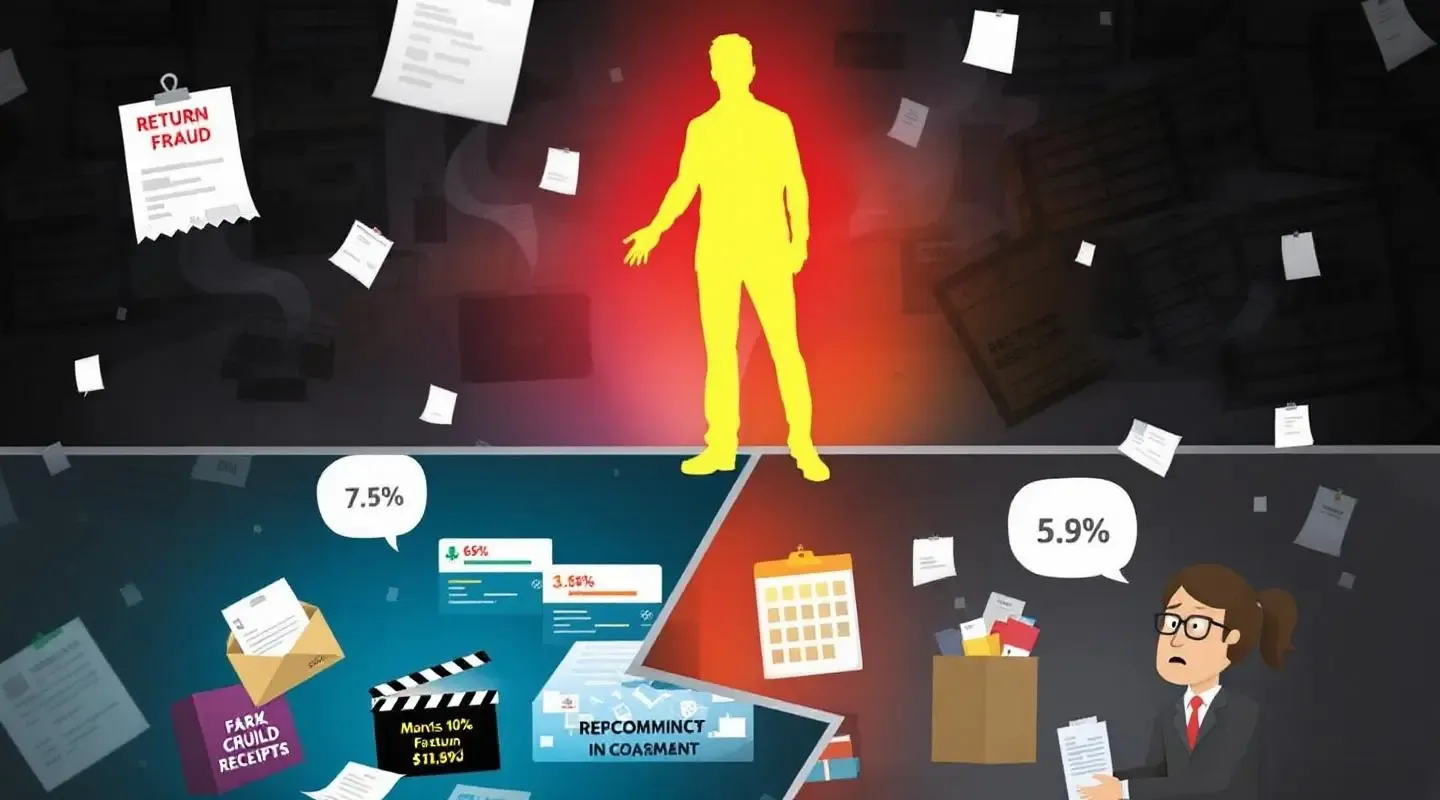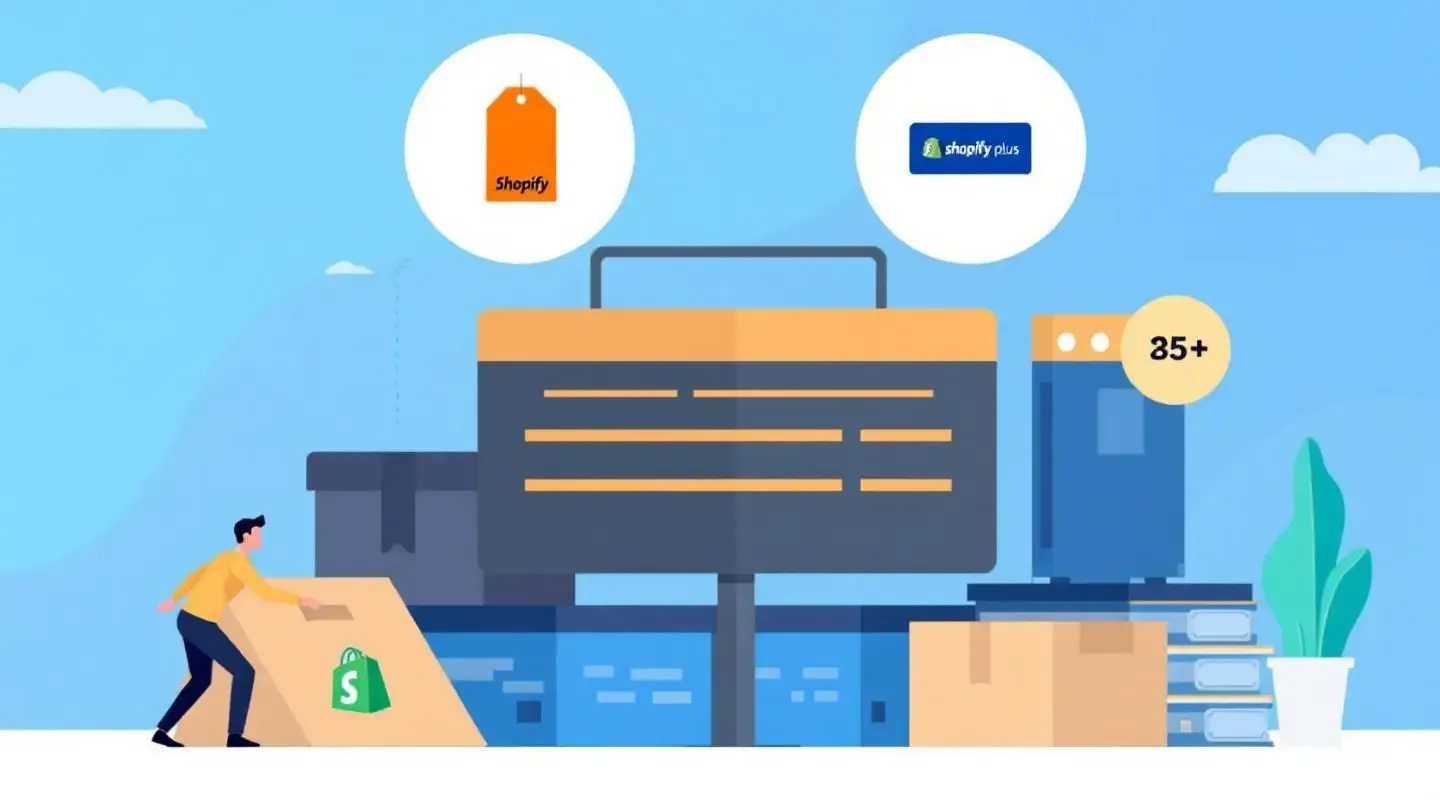Return fraud has evolved from a minor nuisance to a billion-dollar threat that's quietly devastating retail margins across the globe. With fraudulent and abusive returns accounting for over $103 billion in losses in 2024—representing 15.14% of all retail returns—this isn't just a cost of doing business anymore. It's an existential threat to profitability that demands immediate, strategic action.
The numbers are staggering, but the real story lies in the data patterns that reveal how sophisticated fraudsters have become and how unprepared most retailers are to fight back. This comprehensive analysis breaks down the true cost of return fraud, exposes the most damaging tactics being used against your business, and provides a data-driven roadmap for protection.
If you think return fraud isn't affecting your business, you're likely wrong. If you think you can afford to wait to address it, you're definitely wrong.
The Shocking Scale: Return Fraud by the Numbers
The 2024 data reveals a crisis that's accelerating faster than most retailers realize. Here's the stark reality of what return fraud is costing the industry—and likely your business.
The $103 Billion Problem
Industry-Wide Impact:
- $103 billion in total return fraud and abuse losses in 2024 (up from $101 billion in 2023)
- 15.14% of all retail returns are fraudulent or abusive
- $890 billion in total returns projected for 2024
- 93% of retailers report fraud as a significant business issue
Category-Specific Vulnerability:
According to Loop Returns' analysis of millions of transactions:
- Apparel: 6-13% of return value is fraudulent
- Electronics: 8-15% fraud rate, highest dollar impact
- Home Goods: 5-12% fraud rate, growing rapidly
- Beauty/Personal Care: 4-10% fraud rate, increasing sophistication
The Hidden Multiplier Effect
The direct cost of fraudulent returns is just the beginning. Each fraudulent return triggers a cascade of additional costs:
Direct Costs per Fraudulent Return:
- $25-45 average processing cost
- $15-30 shipping and handling
- $10-20 inspection and restocking
- $5-15 customer service overhead
Indirect Costs (Often Overlooked):
- Inventory distortion: False demand signals affecting purchasing
- Cash flow impact: Delayed recognition of actual losses
- Insurance implications: Higher premiums due to fraud claims
- Brand reputation: Customer confusion and negative reviews
Total Cost Multiplier: For every $100 in fraudulent returns, businesses typically lose $150-200 when all costs are considered.
The Acceleration Factor
Return fraud isn't just growing—it's accelerating at an alarming rate:
Year-over-Year Growth:
- 2023: $101 billion in fraud losses
- 2024: $103 billion in fraud losses (+2% growth)
- Fraud Rate: Increased from 13.7% to 15.14% of all returns
Consumer Behavior Trends:
- 76% of shoppers admit to embellishing return reasons (up 39% from 2023)
- Nearly 40% of online shoppers know someone who has engaged in return fraud
- 30% of wardrobing participants do it weekly
- 25% of bracketing abusers engage in the practice weekly
The Anatomy of Return Fraud: Understanding the Enemy
To effectively combat return fraud, you need to understand the sophisticated tactics being used against your business. Modern return fraud has evolved far beyond simple "buyer's remorse" into organized, systematic attacks on retail profitability.
Category 1: Policy Abuse (The "Gray Area" Fraud)
Policy abuse represents the largest volume of fraudulent activity, often flying under the radar because it exploits legitimate return policies rather than breaking them outright.
Wardrobing: The $30 Billion Deception
Wardrobing—purchasing items with the intent to use and return them—has become a mainstream practice with devastating impact:
The Numbers:
- 30% of wardrobing participants engage weekly
- Average loss per incident: $45-120 depending on product category
- Detection rate: Less than 15% of wardrobing is caught
- Resale impact: 60-80% of wardrobed items cannot be resold at full price
Common Wardrobing Scenarios:
- Event Dressing: Purchasing formal wear for special occasions
- Social Media Content: Buying items for photos/videos, then returning
- Seasonal Use: Purchasing winter gear for single trips
- Professional Needs: Buying tools or equipment for one-time projects
Case Study: Fashion Retailer Impact
A mid-size online fashion retailer analyzed their return data and discovered:
- $2.3 million annual loss to wardrobing
- 18% of formal wear returns showed signs of use
- Average time to return: 28 days (just under their 30-day policy)
- Customer overlap: 12% of customers engaged in repeat wardrobing
Bracketing Abuse: The Volume Game
Bracketing—ordering multiple sizes or colors with intent to return most items—creates operational chaos and hidden costs:
The Hidden Costs:
- Processing overhead: 3-5x normal return volume
- Inventory distortion: False demand signals affecting purchasing
- Shipping costs: Multiple return shipments per customer
- Customer service load: Higher inquiry rates from bracketing customers
Data Pattern Recognition:
- Order characteristics: Multiple sizes/colors of same item
- Return timing: Bulk returns within days of delivery
- Customer behavior: Repeat bracketing patterns
- Geographic clustering: Higher rates in certain demographics
Policy Manipulation: Exploiting the Fine Print
Sophisticated customers exploit return policy loopholes with surgical precision:
Common Manipulation Tactics:
- Split Returns: Breaking large orders into smaller returns to avoid scrutiny
- Tag Switching: Swapping tags between sale and full-price items
- Timing Games: Returning items just before policy deadlines
- Channel Hopping: Using different return channels to avoid detection
Category 2: Outright Fraud (The Criminal Enterprise)
Beyond policy abuse lies outright criminal fraud—organized, intentional theft disguised as legitimate returns.
Empty Box Scams: The $15 Billion Heist
Empty box returns represent the most brazen form of return fraud, with increasingly sophisticated execution:
Evolution of Tactics:
- Basic Empty Boxes: Simply returning empty packaging
- Weight Matching: Adding rocks, bricks, or other items to match original weight
- Partial Removal: Removing valuable components while leaving less valuable parts
- Resealing Expertise: Professional-grade repackaging to avoid detection
Detection Challenges:
- Automated Processing: Many returns are processed without inspection
- Volume Overwhelm: High return volumes make individual inspection difficult
- Sophisticated Packaging: Professional resealing techniques
- Timing Exploitation: Returns processed during peak periods with less scrutiny
Industry Impact Data:
- Average loss per incident: $150-500
- Detection rate: 25-40% of empty box returns are caught
- Repeat offender rate: 60% of empty box fraudsters are repeat offenders
- Geographic concentration: Higher rates in urban areas with package theft issues
Return Not Received: The Phantom Return
This sophisticated fraud involves claiming to return items that were never actually sent back:
The Mechanics:
- Fraudulent Tracking: Using fake or unrelated tracking numbers
- Zip Code Gaming: Sending worthless items to the same zip code
- Timing Manipulation: Exploiting return processing delays
- Documentation Fraud: Creating fake shipping receipts and labels
Financial Impact:
- Average loss per incident: $75-300
- Success rate for fraudsters: 40-60% when well-executed
- Detection timeline: Often discovered weeks or months later
- Recovery rate: Less than 20% of losses are recovered
Category 3: Technology-Enabled Fraud (The New Frontier)
The rise of AI and digital tools has created new categories of return fraud that are harder to detect and more damaging than traditional methods.
AI-Generated Evidence: The Deep Fake Returns
Fraudsters are using artificial intelligence to create convincing evidence of product defects:
Emerging Tactics:
- Manipulated Images: AI-altered photos showing fake damage
- Synthetic Reviews: AI-generated complaints to support return claims
- Voice Cloning: Fake customer service calls using cloned voices
- Document Forgery: AI-generated receipts and warranty documents
Detection Challenges:
- Sophistication Level: AI-generated content is increasingly difficult to identify
- Volume Scaling: Automated tools enable mass fraud attempts
- Cost Reduction: Lower barriers to entry for sophisticated fraud
- Evidence Quality: AI-generated evidence can be more convincing than real damage
Identity Theft Returns: The Stolen Identity Scam
Organized fraud rings use stolen identities to create return fraud networks:
The Operation:
- Identity Acquisition: Purchasing stolen personal information
- Account Creation: Setting up fake customer accounts
- Purchase Coordination: Making legitimate purchases to establish credibility
- Fraud Execution: Systematic return fraud across multiple accounts
- Network Expansion: Scaling operations across hundreds of identities
Impact Metrics:
- Average network size: 50-200 fake identities
- Loss per network: $100,000-500,000 annually
- Detection timeline: 6-18 months average
- Recovery rate: Less than 10% of losses recovered
The True Cost Analysis: Beyond the Obvious
Understanding the full financial impact of return fraud requires looking beyond the immediate loss of merchandise. The true cost includes operational disruption, strategic distortion, and long-term competitive disadvantage.
Direct Financial Impact
Immediate Losses:
- Merchandise Value: $103 billion in direct product losses
- Processing Costs: $15-30 per fraudulent return
- Shipping Expenses: $10-25 per return shipment
- Labor Overhead: $5-15 per return in handling costs
Revenue Impact by Business Size:
- Small Businesses (<$1M revenue): 2-5% of total revenue lost to fraud
- Medium Businesses ($1M-$10M): 1.5-3% revenue impact
- Large Businesses ($10M+): 1-2% revenue impact, but higher absolute dollars
Operational Disruption Costs
Inventory Management Chaos:
Return fraud creates false signals that distort inventory planning and purchasing decisions:
Planning Distortions:
- Demand Forecasting: Fraudulent returns skew sales data
- Inventory Turnover: False return rates affect stock level calculations
- Seasonal Planning: Fraud patterns don't match legitimate seasonal trends
- Category Management: Fraud concentration affects product mix decisions
Case Study: Electronics Retailer
A major electronics retailer discovered that return fraud was causing:
- $5 million in excess inventory due to false demand signals
- 15% increase in carrying costs from overstocking
- 20% reduction in inventory turnover in affected categories
- $2 million in markdowns on excess stock
Customer Service Overload:
Fraudulent returns create disproportionate customer service burden:
Service Impact Metrics:
- 3x higher contact rate for fraudulent vs. legitimate returns
- 2x longer resolution time for fraud-related inquiries
- Higher escalation rate due to dispute complexity
- Increased training costs for fraud detection skills
Strategic and Competitive Costs
Policy Tightening Backlash:
Efforts to combat fraud often negatively impact legitimate customers:
Customer Experience Trade-offs:
- Reduced return windows affect customer confidence
- Increased verification requirements create friction
- Higher return fees reduce competitive advantage
- Stricter policies drive customers to competitors
Brand Reputation Impact:
Return fraud can damage brand perception in multiple ways:
Reputation Risks:
- Customer Confusion: Legitimate customers caught in fraud prevention measures
- Negative Reviews: Frustrated customers sharing bad experiences
- Social Media Backlash: Public complaints about return policy changes
- Competitive Disadvantage: Stricter policies compared to competitors
Long-Term Competitive Disadvantage
Innovation Diversion:
Resources spent on fraud prevention could be invested in growth initiatives:
Opportunity Costs:
- Technology Investment: Fraud prevention vs. customer experience improvements
- Staff Allocation: Fraud investigation vs. business development
- Capital Deployment: Loss recovery vs. expansion opportunities
- Strategic Focus: Defensive vs. offensive business strategies
Data Patterns That Reveal Fraud: The Detective's Toolkit
Modern return fraud detection relies on identifying patterns in data that human analysis would miss. Understanding these patterns is crucial for building effective fraud prevention systems.
Customer Behavior Patterns
The Serial Returner Profile:
Data analysis reveals distinct characteristics of fraudulent customers:
Behavioral Indicators:
- Return Rate: >25% return rate (vs. 8-12% average)
- Return Timing: Consistent returns near policy deadlines
- Product Patterns: Focus on high-value, easily resold items
- Communication Style: Aggressive or overly detailed return reasons
Geographic Clustering:
Fraud often concentrates in specific geographic areas:
Location-Based Patterns:
- Urban Concentration: Higher fraud rates in metropolitan areas
- Shipping Address Variations: Multiple addresses for same customer
- P.O. Box Usage: Higher fraud correlation with P.O. box deliveries
- Cross-Border Patterns: International shipping fraud indicators
Purchase Behavior Analysis:
Fraudulent customers exhibit distinct purchasing patterns:
Purchase Pattern Red Flags:
- Bulk Ordering: Large quantities of same item
- Price Point Focus: Concentration on high-value items
- Category Clustering: Focus on easily resold categories
- Payment Method Patterns: Preference for certain payment types
Product and Category Patterns
High-Risk Product Identification:
Certain products are disproportionately targeted by fraudsters:
Fraud-Prone Categories:
- Electronics: High value, easy resale, complex return reasons
- Designer Apparel: High value, subjective fit issues
- Jewelry: Extremely high value, small size for shipping
- Beauty Products: Subjective satisfaction, hygiene concerns
- Home Goods: High shipping costs, damage claims
Seasonal Fraud Patterns:
Return fraud follows predictable seasonal patterns:
Seasonal Trends:
- Holiday Season: 40% increase in wardrobing fraud
- Back-to-School: Electronics and clothing fraud spikes
- Wedding Season: Formal wear and jewelry fraud increases
- End-of-Quarter: B2B fraud attempts increase
Transaction Pattern Analysis
Return Timing Indicators:
The timing of return requests reveals fraud patterns:
Suspicious Timing Patterns:
- Immediate Returns: Returns requested before delivery
- Deadline Gaming: Returns clustered near policy deadlines
- Bulk Return Days: Multiple returns on same day
- Weekend Patterns: Higher fraud rates on weekends
Communication Pattern Analysis:
The language and style of return requests can indicate fraud:
Linguistic Fraud Indicators:
- Overly Detailed Explanations: Excessive justification for returns
- Generic Complaints: Copy-paste return reasons
- Emotional Manipulation: Sob stories or aggressive demands
- Technical Jargon: Unusually precise technical language
Conclusion: The Path Forward
Return fraud is no longer a minor cost of doing business—it's a sophisticated threat that demands an equally sophisticated response. By understanding the true scale of the problem, recognizing the patterns that reveal fraud, and implementing data-driven prevention strategies, retailers can protect their margins while maintaining positive customer experiences.
The most successful retailers will be those who view return fraud prevention not as a cost center but as a strategic advantage that improves profitability, operational efficiency, and long-term competitive positioning.




